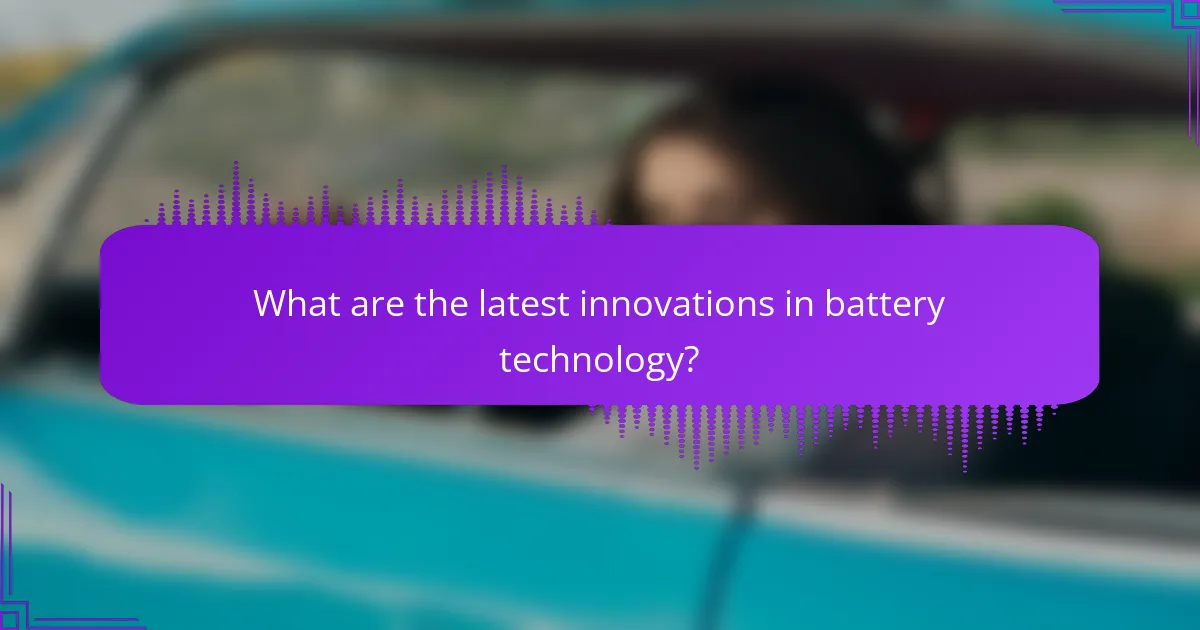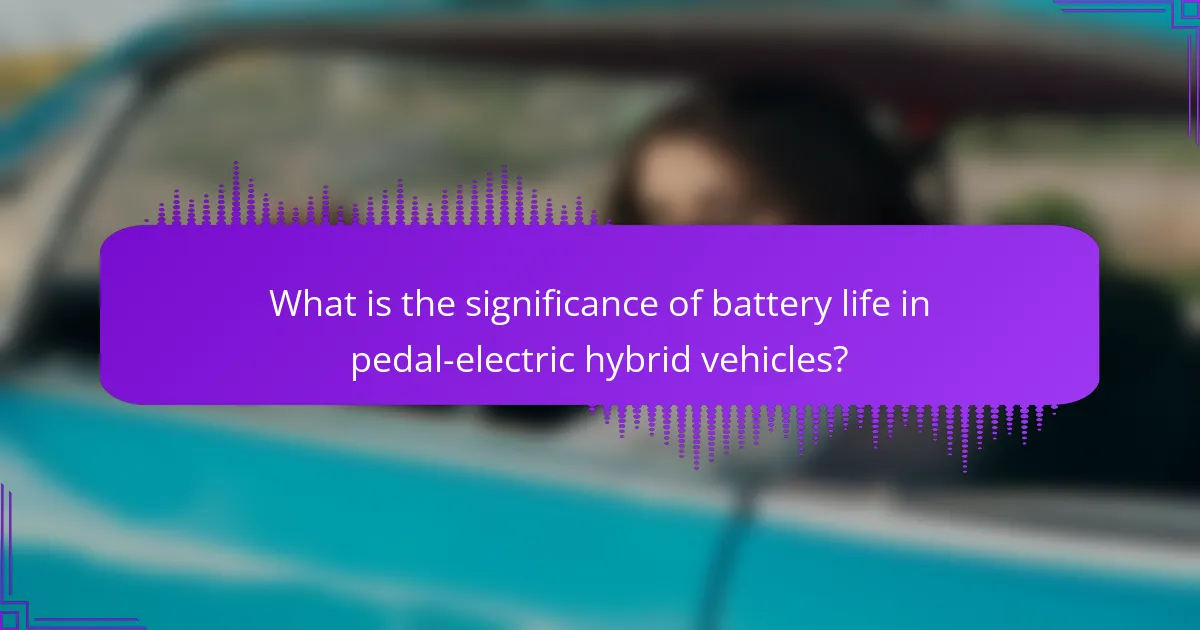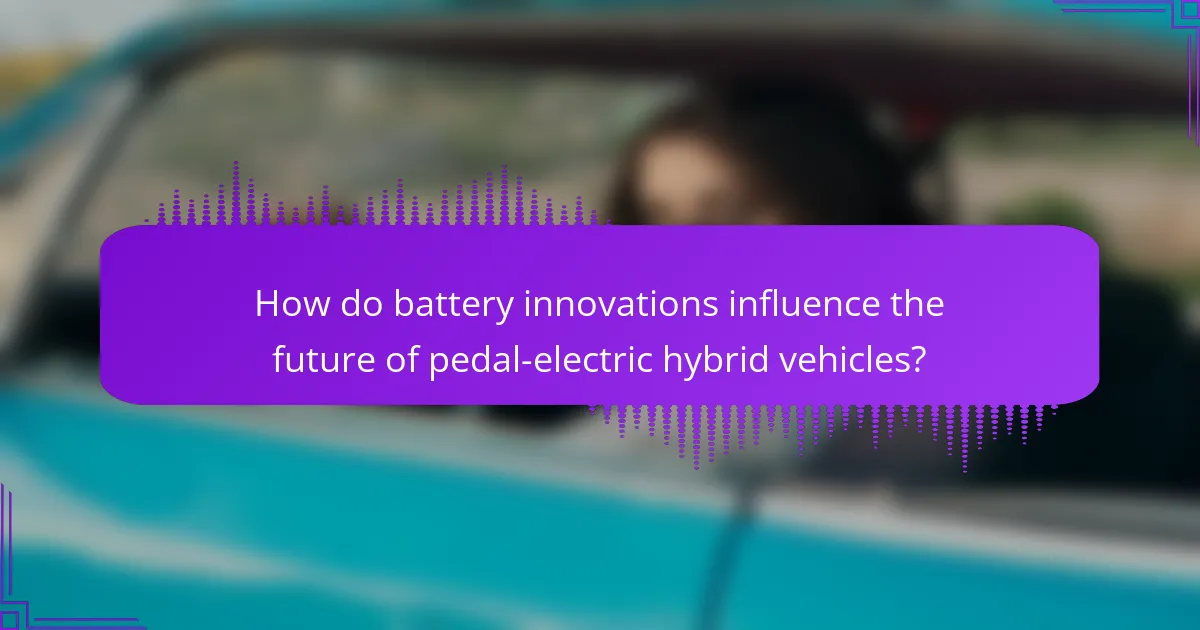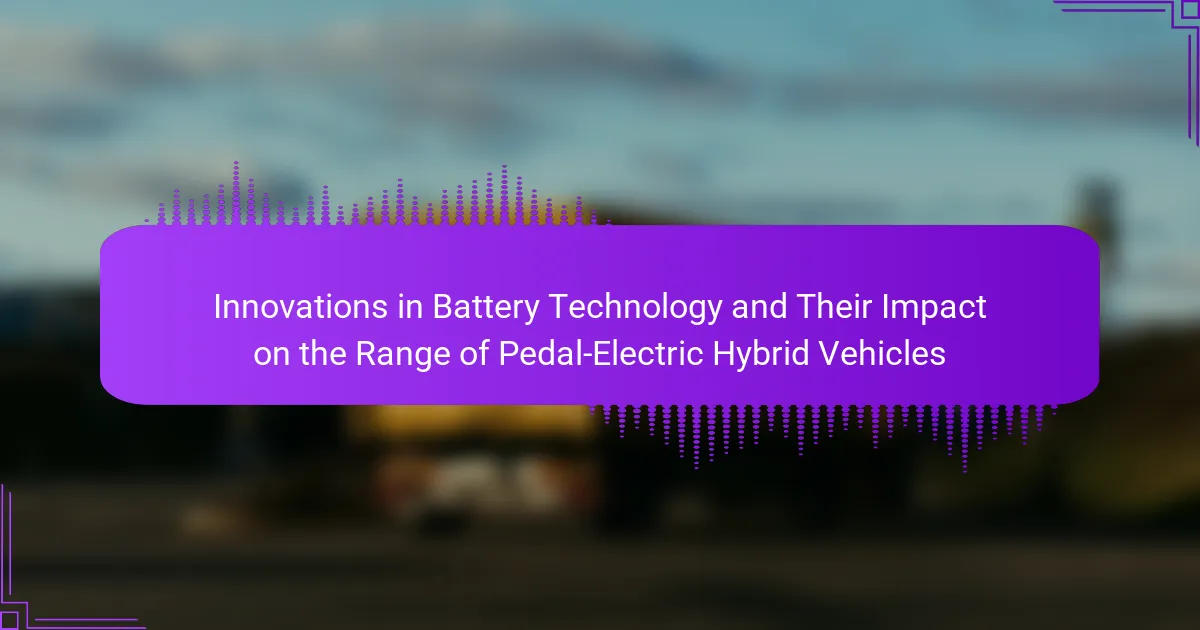
What are the latest innovations in battery technology?
Solid-state batteries represent a significant innovation in battery technology. They replace liquid electrolytes with solid materials. This change enhances safety and energy density. Solid-state batteries can potentially store more energy in a smaller space. Research indicates they may offer up to 50% higher energy density compared to traditional lithium-ion batteries. Another innovation is lithium-sulfur batteries. These batteries promise a higher energy capacity and lower cost. They can theoretically achieve energy densities of 500 Wh/kg. Additionally, fast-charging technology has improved. New methods allow batteries to charge in minutes rather than hours. Researchers are also exploring graphene batteries. These batteries can conduct electricity more efficiently and charge faster. Each of these innovations aims to improve battery performance and longevity.
How do these innovations impact electric vehicle performance?
Innovations in battery technology significantly enhance electric vehicle performance. Improved battery energy density allows vehicles to travel longer distances on a single charge. For instance, advancements have led to energy densities exceeding 250 Wh/kg. This results in increased range, reducing the frequency of charging stops. Faster charging capabilities allow for shorter downtime, enhancing convenience for drivers. Additionally, innovations in thermal management improve battery longevity and efficiency. Enhanced battery management systems optimize energy usage during operation. Overall, these innovations lead to better performance, efficiency, and user experience in electric vehicles.
What are the key advancements in battery chemistry?
Key advancements in battery chemistry include the development of lithium-sulfur and solid-state batteries. Lithium-sulfur batteries offer higher energy density compared to traditional lithium-ion batteries. They can potentially reach energy densities of 500 Wh/kg, significantly improving range. Solid-state batteries replace liquid electrolytes with solid materials, enhancing safety and stability. These batteries can also provide faster charging times and longer lifespans. Research indicates that solid-state technology can increase energy density to over 300 Wh/kg. These advancements are crucial for improving the efficiency and performance of pedal-electric hybrid vehicles.
How does battery capacity influence vehicle range?
Battery capacity directly influences vehicle range by determining how much energy is stored for propulsion. A higher battery capacity allows for more energy, increasing the distance a vehicle can travel on a single charge. For example, a vehicle with a 60 kWh battery can typically achieve a range of about 200-300 miles, depending on efficiency. In contrast, a 30 kWh battery may only provide a range of 100-150 miles. Additionally, factors such as vehicle weight, aerodynamics, and driving conditions also play a role in range. Thus, larger battery capacities generally correlate with longer ranges, enhancing the practicality of electric and hybrid vehicles.
Why is battery weight important for hybrid vehicles?
Battery weight is crucial for hybrid vehicles because it directly affects efficiency and performance. Heavier batteries can reduce overall vehicle efficiency by increasing energy consumption. This leads to decreased fuel economy and shorter electric range. A lighter battery allows for better acceleration and handling. It also enables manufacturers to optimize design for weight distribution. Studies indicate that a reduction of battery weight by 10% can improve range by 5-10%. Therefore, minimizing battery weight is essential for enhancing the performance of hybrid vehicles.
What role does battery size play in vehicle design?
Battery size is crucial in vehicle design as it directly influences range, weight, and performance. A larger battery typically provides a longer driving range, allowing vehicles to operate without frequent recharging. This is essential for consumer satisfaction and usability. However, increased battery size also adds weight, which can affect vehicle dynamics and efficiency. For example, heavier vehicles may require more energy to accelerate, impacting overall performance. Additionally, the design must accommodate the physical space required for larger batteries, influencing the vehicle’s layout and aerodynamics. Manufacturers must balance these factors to optimize performance and consumer appeal.
How does weight reduction improve efficiency?
Weight reduction improves efficiency by decreasing the energy required for propulsion. Lighter vehicles require less power to accelerate and maintain speed. This leads to improved fuel economy and extended battery life in hybrid vehicles. For instance, a reduction of 10% in vehicle weight can enhance fuel efficiency by approximately 6-8%. Additionally, lower weight allows for smaller batteries, which can reduce costs and increase cargo capacity. Therefore, weight reduction is a critical factor in optimizing the performance of pedal-electric hybrid vehicles.

What is the significance of battery life in pedal-electric hybrid vehicles?
Battery life in pedal-electric hybrid vehicles is crucial for overall performance and usability. It directly impacts the driving range and efficiency of the vehicle. A longer battery life allows for extended travel distances without frequent recharging. This is particularly important for users who rely on these vehicles for daily commuting or longer trips. Additionally, battery life affects the vehicle’s weight and design, influencing its overall efficiency. High-capacity batteries can enhance the hybrid system’s ability to provide power assistance while pedaling. Studies show that improvements in battery technology lead to better performance metrics, such as faster charging and longer life cycles. These advancements contribute to the growing popularity and practicality of pedal-electric hybrid vehicles.
How does battery lifespan affect user experience?
Battery lifespan significantly affects user experience by determining how long a device can operate before needing a recharge. A longer battery lifespan enhances convenience, allowing users to engage with their devices without frequent interruptions. This is particularly important for pedal-electric hybrid vehicles, where extended battery life can influence travel distance and overall usability. Studies show that users prefer vehicles with batteries lasting over 100 miles on a single charge. In contrast, shorter lifespans can lead to frustration and decreased satisfaction. Therefore, advancements in battery technology that extend lifespan can greatly improve user experience in hybrid vehicles.
What factors contribute to battery degradation?
Battery degradation is primarily influenced by temperature, charge cycles, and chemical reactions. High temperatures accelerate chemical reactions within the battery, leading to faster degradation. Conversely, extremely low temperatures can also impair battery performance and lifespan. Frequent charge and discharge cycles contribute to wear and tear, reducing overall capacity over time. Additionally, lithium-ion batteries experience solid electrolyte interphase (SEI) growth, which consumes active lithium and decreases efficiency. Other factors include overcharging, which can cause thermal runaway, and the use of low-quality materials that may not withstand prolonged use. Research shows that maintaining optimal charging conditions can significantly extend battery life.
How can manufacturers extend battery life?
Manufacturers can extend battery life by optimizing battery chemistry and improving thermal management. Advanced lithium-ion chemistries enhance energy density and longevity. Implementing smart charging algorithms prevents overcharging and minimizes stress on the battery. Additionally, integrating better cooling systems helps maintain optimal operating temperatures. Research indicates that maintaining temperatures between 20°C and 25°C can significantly prolong battery lifespan. Regular software updates can also optimize energy management and performance. These strategies collectively contribute to a more durable and efficient battery system.
What are the environmental impacts of battery disposal?
Battery disposal has significant environmental impacts. Improper disposal can lead to soil and water contamination. Batteries contain hazardous materials like lead, cadmium, and lithium. These substances can leach into the environment, harming ecosystems. Additionally, the production of new batteries requires mining, which can lead to habitat destruction. Recycling batteries can mitigate these impacts by recovering valuable materials. According to the Environmental Protection Agency, recycling reduces the need for new raw materials and minimizes waste. Proper disposal and recycling are essential for protecting the environment.
How do recycling processes work for batteries?
Recycling processes for batteries involve several key steps. First, batteries are collected and sorted by type. Then, they undergo disassembly to separate components. The materials are processed to recover valuable metals such as lithium, cobalt, and nickel. Chemical processes are employed to extract these metals safely. The recovered materials can be reused in new batteries. This process reduces the need for raw material extraction. According to the International Energy Agency, recycling can recover up to 95% of lithium from batteries. This not only conserves resources but also minimizes environmental impact.
What are the benefits of sustainable battery production?
Sustainable battery production offers numerous benefits, including reduced environmental impact and resource conservation. It minimizes harmful emissions during manufacturing, contributing to cleaner air. Sustainable practices also promote the use of renewable energy sources, further decreasing carbon footprints. Additionally, sustainable battery production often involves recycling materials, which reduces waste and conserves natural resources. This approach can lead to lower production costs over time by utilizing recycled materials. Research indicates that sustainable methods can enhance battery efficiency and lifespan, promoting longer use and less frequent replacements. Overall, these practices support a circular economy, fostering a more sustainable future for energy storage solutions.

How do battery innovations influence the future of pedal-electric hybrid vehicles?
Battery innovations significantly enhance the efficiency and range of pedal-electric hybrid vehicles. Advanced battery technologies, such as lithium-sulfur and solid-state batteries, offer higher energy densities. These innovations result in longer distances that can be traveled on a single charge. For instance, lithium-sulfur batteries can potentially provide up to 500 Wh/kg, compared to traditional lithium-ion batteries, which typically offer around 150-250 Wh/kg. Improved charging speeds also reduce downtime for users. Additionally, innovations in battery management systems optimize performance and longevity. Enhanced thermal management ensures batteries operate safely under various conditions. Overall, these advancements directly contribute to the practicality and appeal of pedal-electric hybrid vehicles in the market.
What trends are emerging in battery technology?
Emerging trends in battery technology include solid-state batteries, increased energy density, and fast charging capabilities. Solid-state batteries use a solid electrolyte, enhancing safety and performance. Research indicates they can offer up to twice the energy density of traditional lithium-ion batteries. Increased energy density allows for longer ranges in electric vehicles. Fast charging technology is advancing, with some batteries capable of charging to 80% in under 30 minutes. Additionally, recycling and sustainability practices are gaining importance in battery production. The global battery recycling market is projected to grow significantly, driven by the need to recover valuable materials. These trends collectively enhance the efficiency and sustainability of battery systems in various applications.
How are manufacturers adapting to consumer demands?
Manufacturers are adapting to consumer demands by investing in advanced battery technology. They are developing batteries with higher energy densities to extend the range of pedal-electric hybrid vehicles. This change responds to consumer preferences for longer travel distances without frequent recharging. Additionally, manufacturers are integrating fast-charging capabilities to reduce downtime. They are also focusing on sustainability by using eco-friendly materials in battery production. Research shows that 70% of consumers prioritize range and charging speed in their purchasing decisions. This data drives manufacturers to innovate continuously. As a result, the market sees a wider variety of battery options tailored to consumer needs.
What role does government regulation play in battery innovation?
Government regulation plays a crucial role in battery innovation. Regulations establish safety standards that ensure the reliability of battery technologies. They also incentivize research and development through grants and subsidies. For example, the U.S. Department of Energy has funded numerous projects aimed at enhancing battery efficiency. Additionally, regulations can promote environmental sustainability by setting limits on harmful materials used in batteries. This encourages companies to innovate in developing eco-friendly alternatives. Furthermore, government policies can create a stable market, which is essential for long-term investment in battery technologies. Overall, effective regulation drives advancements that improve battery performance and sustainability.
What are the challenges facing battery technology development?
The challenges facing battery technology development include limited energy density, high costs, and resource scarcity. Energy density affects how much power a battery can store. Current lithium-ion batteries have a maximum energy density of about 250 Wh/kg. High production costs hinder widespread adoption. The average cost of lithium-ion batteries was approximately $137 per kWh in 2020. Resource scarcity poses issues for materials like lithium and cobalt, which are essential for battery production. Mining these materials can also have significant environmental impacts. Safety concerns, such as thermal runaway, further complicate battery technology development. These challenges must be addressed to improve battery performance and sustainability.
How do cost factors affect battery innovation?
Cost factors significantly influence battery innovation by determining research and development budgets. Higher costs can limit the resources available for exploring new materials and technologies. Consequently, manufacturers may prioritize cost-effective solutions over advanced innovations. For example, lithium-ion batteries dominate the market due to their balance of cost and performance. Research indicates that reducing production costs can lead to wider adoption of alternative battery technologies. According to a study by the International Energy Agency, decreasing costs of battery storage systems is crucial for enhancing electric vehicle adoption. Thus, cost factors directly shape the pace and direction of battery innovation.
What technical hurdles must be overcome for advancement?
Battery technology faces several technical hurdles for advancement. One major hurdle is energy density. Current batteries often do not store enough energy to extend vehicle range significantly. Another challenge is charging speed. Many existing batteries take too long to recharge, limiting usability. Thermal management is also critical. Batteries can overheat, which affects performance and safety. Durability and lifespan present additional issues. Frequent cycling can degrade battery materials over time. Cost remains a significant barrier as well. High-performance batteries often come with prohibitive manufacturing costs. Lastly, recycling and sustainability are concerns. Developing eco-friendly disposal methods is essential for long-term viability. These hurdles must be addressed to enhance battery performance in pedal-electric hybrid vehicles.
What practical tips can consumers consider when choosing a pedal-electric hybrid vehicle?
Consider the battery capacity when choosing a pedal-electric hybrid vehicle. A higher capacity typically means a longer range. Evaluate the vehicle’s weight; lighter models often perform better. Check the charging options available. Fast charging capabilities can enhance convenience. Look for regenerative braking features; they help recharge the battery while driving. Assess the warranty on the battery; longer warranties indicate manufacturer confidence. Research the vehicle’s efficiency ratings; higher ratings often result in cost savings. Finally, read consumer reviews to gauge real-world performance and reliability.
The main entity of this article is battery technology, specifically innovations that enhance the performance and range of pedal-electric hybrid vehicles. It covers advancements such as solid-state and lithium-sulfur batteries, which offer higher energy densities and faster charging capabilities. The article also discusses the significance of battery capacity, weight, and lifespan in influencing vehicle range and user experience. Additionally, it addresses the environmental impacts of battery disposal and the importance of sustainable production practices. Overall, these innovations are pivotal in improving the efficiency and practicality of pedal-electric hybrid vehicles in the market.
